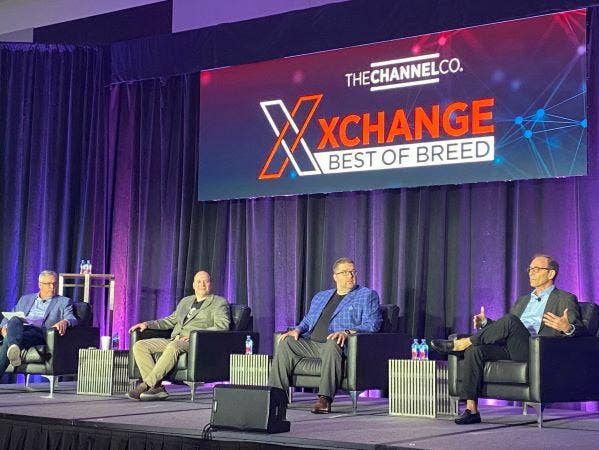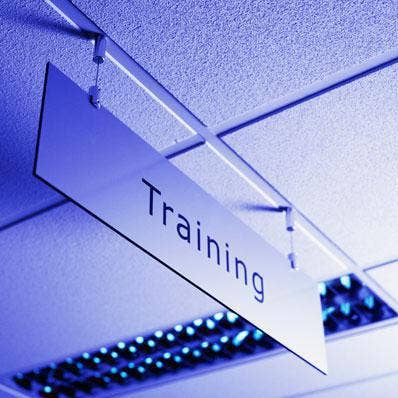6 Tips MSPs Should Know About Going Into 2023
‘It’s not a buying conversation anymore. It’s much, much broader than that. It’s a service conversation around marketplaces,’ says Ryan Walsh, chief operating officer of Pax8.

MSPs can take lessons learned from the pandemic and leverage different strategy efforts to transform their businesses in 2023, according to a panel of channel executives.
At CRN’s parent company The Channel Company’s XChange Best of Breed Conference in Atlanta this week, Ryan Walsh, COO of Pax8; Dan Tomaszewski, EVP of channel at Kaseya; and Ryan Bowman, director of solutions engineering for ThreatLocker, came together to discuss the channel outlook, what partners can do to adapt going forward and what to leverage to grow their business.
The panel was moderated by Tom Colleary, president and CEO of West Hartford, Conn.-based MSP F3 Technology Partners.
When discussing strategy and partner engagement, Tomaszewski said that vendors want to make sure that its solutions are profitable for the partners.
“It’s one thing just to have a solution and have it be the right thing in your stack,” he said. “But how do we make sure that it’s profitable? How do we make sure it’s easy to deploy? In going through that whole strategy with our customers, we found that being able to really get in the trenches more and through that go to market and that onboarding process with you…we’re seeing customers go to market in 30, 60 days with products.
“Seeing success in recouping the cost of what they just shelled out, they’re now able to go out there and do things profitably,” he added.
At Pax8, Walsh said they’re driven by two things, time to value and ease of business, “especially now with the economic landscape the way it is.”
The panel discussed partner engagement strategies, go forward strategies and marketplace and how they can help partners help their end customers.
Adam Goebel, director of partner management for Missouri-based MSP All Covered, said what the panel said validated what his company is doing coming out of the pandemic.
“It seems like they’re doing the same thing and they’re trying to do things that we want to do to help us grow,” he said.
The panel discussed partner engagement strategies, go forward strategies and marketplace and how they can help partners help their customers.
Here’s a breakdown of what they said.

Remote/Hybrid Work Is Here To Stay
Bowman said the hybrid and work from home model accelerated in 2020 and isn’t going away.
“I think it was already happening, in least in some industries,” he said. “Now it‘s something new that we all have to deal with and adapt to and we get a lot of good out of it.”
Tomaszewski said Kaseya understood what their partners and their partner’s customers were going through, “so we were going through those roadmaps and bumps and technology releases and trying to figure out how do we adopt to that hybrid environment or how it can go to a fully remote environment.”
As a startup, Walsh didn’t believe Pax8 could work remote.
“We were building our airplane in the sky,” he said. “What we learned is that we were wrong. What was so great about the go forward for our business, and what we were wrong about, was the need to adapt to change and support and utilize how cloud can enable that change.”
What he and the Pax8 team learned is the importance of maintaining culture through that, but also taking advantage of the technology and helping educate and enable partners.

Partner Engagement Strategies Have Shifted
Walsh said what changed “radically” for Pax8 was how selling happened.
“With Pax8 as a cloud marketplace with lots of amazing vendor solutions, enablement became the name of the game,” he said. “The vendors really want to get their products sold, but how does a channel partner ecosystem get involved in that, and that was all about adding value.”
He said Pax8 was tracking a trend that customers expected a level of education from their partners, “So enablement took a whole new level for us.”
The distributor offered training and hands-on work as he said digital transformation efforts typically fail due to lack of training.
“Companies were not digital,” Tomaszewski said. “They were used to being in person. Those companies that had no digital strategy…we really had to step up our game.”
He said Kaseya went to a whole digital platform, giving partners digital resources, doing webinars, doing digital sales calls and being an extension of their team.
“You can’t just give people content anymore,” he said. “You got to be able to go through what’s the value, how do you relate to this. What are we seeing what works, what doesn‘t work? We really just tried to step up that game from an enablement standpoint.”

‘Let’s Create Together’
Tomaszewski said Kaseya focuses on when a partner buys a product or service through them, they want to make sure that the partner’s go to market is successful.
“How do you price it? How do you package it? What’s the geographical things in your market?” he said. “We want to make sure that we’re giving you the best information to where you can go to market successfully.”
Pax8 recently did an uplift to their partner program to then take the internal driver and go outside in.
“What do our partners want in terms of their business?” Walsh said. “There’s three things we‘re trying to understand, what’s your business objective, and we‘ll align up our solution and the vendor products around that, gain efficiencies and reduce risk.”
For Bowman, it’s providing the resources to partners that they need.
“Let’s create together,” he said. “You have some knowledge of the market. Let’s work together. Let’s build some materials that we’ll share with everybody and you all benefit from the other things that have been created.”

‘I t's A Service Conversation Around Marketplaces’
While ThreatLocker primarily uses a direct sales model, they do work with some partners to get ThreatLocker out in front of partners, “and we’re looking to perhaps enhance that,” Bowman said.
As Pax8 is a cloud marketplace, their strategy is to provide more options for partners in light of taking advantage of marketplaces.
“My view about that is if you‘re a vendor, you need to get in one,” Walsh said. “If you’re a partner, you need to have one to conveniently deliver cloud solutions to your customer the way they want. You’ve got to get in the game, no matter what.”
Going to market helps Pax8 understand their partners better and then tailor the cloud marketplace, which can be branded for each of their partners in the solutions that they want in there.
“So much today, the conversation is how are you automating and maximizing your technology stack and are you covered,” Walsh said. “That allows you to improve your growth, but more importantly, when you really think about the future vision of a marketplace, it‘s got to be even broader than that. It’s got to be connecting an ecosystem that hasn‘t been connected before. It is how do you better serve your customer. It’s not a buying conversation anymore. It‘s much, much broader than that. It’s a service conversation around marketplaces.”

Partners Should Leverage Resources
With the partner ecosystem always changing, it can be tough for partners to keep up.
When Bowman talks to partners time and again, he’ll hear that they’re sometimes struggling. And when he asks if they asked for help, the answer is usually no.
“That‘s what we’re here to do,” he said. “We‘re trying to enable our partners, we have resources, we’re developing things to help you guys do your job, do it efficiently and do it correctly.
“There‘s more resources available from vendors today than there have ever been in the past. Just use them,” he added.
Tomaszewski said Kaseya is investing heavily into resources internally, not to sell partners products or solutions, but to help them sell the solutions that they have.
“Let us engage with you and figure out what‘s your strategy, what’s going on, and then we can give you the information to how you can excel in your business,” he said.
As they share information with partners, it’s allowing them to grow and succeed.
“I think we’re seeing some of the things that are changing around us, so let us help you through the information sharing and changes to be able to help you grow your business,” he said.

The Importance Of Compliance
Tomaszewski sees end users struggling with compliance.
“I think it’s really important today that we’re going in, looking at the frameworks and that we’re dropping compliance standards in giving our end customers the understanding of how to be compliant,” he said. “It drives all the security right behind it. All the different controls and things that you’re going to be putting into place are the security measures and the security products you need. But they need that understanding from a compliance standpoint.”
He said customers believe if they have a cyber insurance policy than they’re good.
“It‘s time to document it. It’s time to give them a portal, give them access to their compliance and help them understand,” he said. “It really is the value thing that I think is missing, to really have people understand why they need all these other security products, why they need these additional services. It helps demonstrate that value for them.”
Walsh said end users also struggle to adapt to change and operate faster.
“You’ve got to align your solution offering to address those two means,” he said. “Security is a great example, that adapt to remote workforce. Now how are you adapting to change? Are you covered in your security tech stack now in a way that you didn’t need to be before? This is what your customers are asking you to do. And your go to market plans need to speak to that.”